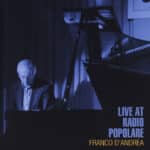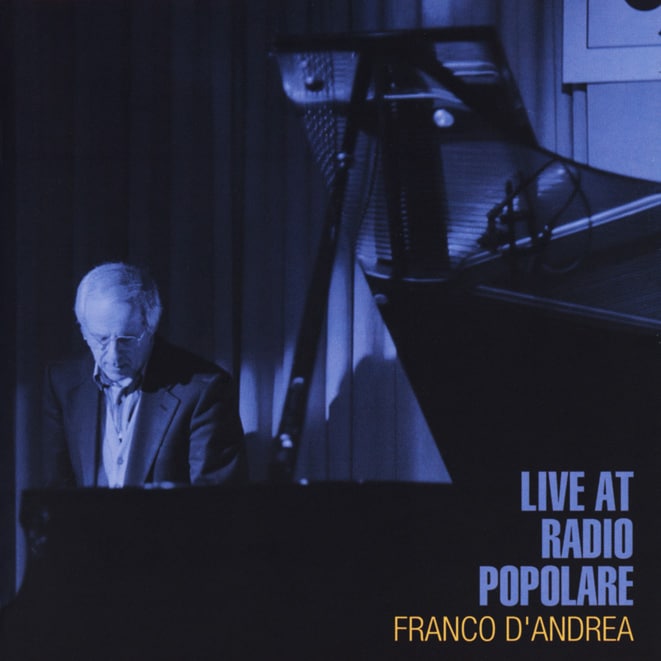Recording piano solos is certainly not unusual for Franco D’Andrea, who since 1978 has been doing that with NUVOLAO, DIALOGUES WITH SUPEREGO, ES, LIVE IN PERUGIA, SOLO FOR CHET, PLAYS MONK, the eight volumes of SOLO and the two «trios with himself» of THREE LINES and BLUES ON MY MIND. Nevertheless, on the night of March 16, 2005 his piano solo was different, «because I was feeling like I could do anything: from the most abstract, craziest, most unjustified and delirious thing to a totally normal one. I could even have played just Dixieland. There are concerts when you just tell yourself: “I’ll play but I won’t dare to step over the line.” You set a limit to yourself. But not that night». (*)
What inspired so much freedom was the sort of listeners who were crowding the Radio Popolare concert hall (in addition to those who were listening to the concert on the radio): «It’s a very open audience. I’d already experienced that two years ago and I’d told myself: “Here I can easily do whatever I please. And they’ll follow me”. They have a sort of candor. They’re not even a jazz audience, because in front of a jazz audience you can perceive those who’d rather have you to play straight and those who’d rather have you to play free or whatever and this can even be a kind of instruction that they give you and sometimes it’s not exactly nice. On the contrary, the listener of Radio Popolare is used to listening to the most diverse genres of music: not just jazz but everything. Those listeners possess the healthy curiosity of the people who are interested in culture in general and in music: they listen and take notice. They don’t say beforehand: “This is good, this is bad”. I found out that it’s a fantastic audience».
Whether it concerns existing materials or it has the characters of an «absolute» impromptu performance, even the choice of the kind of music to play after the one that’s just been played is the result of the relationship with the audience and is made on the spur of the moment, as long as the concert proceeds: «I’m actually always ready to do anything. But, if I feel that among the audience something is not working quite right, the ritual (that I believe a concert is) doesn’t take place, because it lacks the counterpart: I’m officiating, so to speak, a sort of a ritual – it’s secular but it’s still a ritual – and the audience is my fundamental counterpart. It’s useless for me to try something if the people don’t respond: I have to get them to follow me».
And the audience keep on sending out signals, «little coughs, strange motions… Every now and then I peep and I see. Not that I’m constantly gazing at the audience: I’m concentrating on music but every now and then I feel something. For instance, I hear that there’s no silence in a place where there should normally be; I hear whispers, I hear a little something and I think: “They lost their concentration: something’s wrong. I must hit another key, because I must get in contact again”. When I play in front of an audience, I think that they’re there and it’s fundamental. Otherwise, at home, I do what I please – of course – but I’m alone».
In a concert of improvised music, the beginning is very important, both because it’s the first contact with the audience and because it sets the climate where music will move (or where it may try to escape from). In D’Andrea’s concerts it’s «something where there’s no immediate direction: I mean that it must let you go here or there, try all the options. Therefore it generally tends to be totally improvised. It’s as if it’s needed to slowly enter the subconscious, to enter the world of things, when they’re still all mixed up and undifferentiated.» Like the overture in an opera, it already contains a lot of what’s going to happen later: «It’s not deliberate but it almost always happens this way. The first tune already sets the tone of the night: where I’ll go.» That night, Freely forecast «something blues, something traditional, something more abstract, something unidentified and so on».
All those promises were kept, starting with the blues, that makes an immediate return (not formally but through some stylistic elements, pronunciations) with Bluesy and then unites compositions belonging to different jazz eras, such as C Jam Blues and W.R.U., that interpenetrate each other in D’Andrea’s improvisation: «Leaving aside the fact that Ornette Coleman also did some proper blues numbers, his way of articulating the notes was all bluesy: he always had something bluesy in himself. It’s something that he shared with Ellington; and with Monk, after all. After so much time, you feel them closer».
Among the musicians «whom we could easily listen to as if they had played that stuff the other day», it’s just Monk who, along with Mingus, in D’Andrea’s opinion has the highest degree of blues in himself (as one can already understand through some Monk-ish hints in Bluesy). A special meaning has the insertion of Misterioso between two of Armstrong’s hits, with the reappearance of Misterioso at the beginning of the latter – Savoy Blues – for a brief moment: «They’re both blues numbers. After all, I’ve always perceived in Monk a strong link with the roots of blues and of jazz in general. And I always associate Monk with classic jazz. I feel that, unlike Bud Powell, Monk had listened to it and enjoyed it. In Monk’s soul there were some elements even from the Swing Era: there are rhythm patterns that come right from there. Right when he was improvising, when he was creating. Then the notes were crazy; but, if you perceive certain things in their rhythmic aspect, you immediately realize that. And you feel that some of his blues numbers are real blues: Blue Monk sounds like Tin Roof Blues. It means that he knew it, that he’d listened to it, that he’d enjoyed it. The echo of that blues is too strong: a fine moment in his life. Otherwise it’s impossible to play it like that and to compose such an earnest piece of music of your own. And I feel at ease with this, because I enjoyed it too: playing traditional jazz was great. I still have good memories of the years when I did that».
It’s a mark that also comes out of the improvisation explicitly called Roots («it’s got a lot to do with the early Ellington and stuff like that»), where the roots – that are part of it as «spots, little quotes» – go deep (besides blues) into the years of D’Andrea’s adolescence, when he started as a trumpet and clarinet player in an amateur band in Merano.
A short phrase of Roots had already appeared in the early improvisations and will surface again in M2 (whose title makes a reference to the insistence of the major second interval, that becomes structural, at times): it’s a phenomenon that happens quite often during D’Andrea’s concerts, contributing to setting their mood. So Six Bars, before closing the last medley and the record, peeps out for a moment within C Jam Blues, that in its turn shows itself again a couple of minutes into W.R.U.: «It’s all a ballet».
Among the numbers signed by D’Andrea, the only one that was not improvised is Two Colors, that is dropped after just a couple of minutes «because I was under the impression that it wasn’t working right, for some unknown reason. It’s just a matter of sensibility: there was no rational reason. Two Colors could have worked but all of a sudden I told myself: “This is no night for Two Colors. I must go elsewhere: where? There’s something fake in this Two Colors”. And I went into Epistrophy, which was true instead.» The passage takes place thanks to a bass pattern of Two Colors, that in that moment brings to the pianist’s mind the one that is present in his favorite version of Epistrophy: the first arrangement, recorded by Monk on July 2, 1948 (with Milt Jackson on vibraphone, John Simmons on double bass and Shadow Wilson on drums for GENIUS OF MODERN MUSIC, VOL. 1 on Blue Note) and he never resumed again.
Joints are another crucial point of improvisation. It’s a little cell that D’Andrea isolates from the theme of Fascinating Rhythm that diverts the improvisation on Turkish Mambo: «Three adjacent notes, in a peculiar way and in that form are important. I found that out this way. Mainly because I later speeded Fascinating Rhythm up and it turned out to be a bit more abstract, quicker. Three notes in a different order but the intervals are more or less the same.» The piano solo rendition of Turkish Mambo had been for some time an urge for D’Andrea and it was also a way to make his own at last a composition that had always fascinated him also for the way that Tristano (pioneeringly, in 1955) built it, overdubbing the piano several times: «It’s like a quartet of African music, where three musicians play obbligato patterns – always the same, that get mingled, mixed up – and the fourth, the leader, is the only one who’s freely improvising. There’s a polyrhythmic weaving of mismatches, but with very precise patterns and the fourth is on top, in a sort of African way. I don’t think that he meant it like that but that’s how I live it».
Through other authors’ compositions, D’Andrea makes a journey among the cardinal points that orientate his concept of music: «Sooner or later, they always come. Maybe just for a minute or two or on other nights for ten minutes; but it’s rare that none of them is present: Monk, Ellington… even Gershwin, after all: he’s the one who gives me more happiness, when I listen to his songs (more than Cole Porter or Rodgers, for example) and therefore he’s another of my favorite composers. Spencer Williams means traditional jazz, after all: at the end of the day, that’s what it’s about».
Many themes – probably I Got Rhythm and Lover Man more than everything else – are dealt with, as it is typical of D’Andrea, by going around them, attacking them from the back, opening windows, taking them apart in fragments to be let in and out like pivots of improvisation, that is not centered on the changes, that anyway surface now and again, but on the series of references to single parts of the source composition or to its aura. In I Got Rhythm, for example «after a while, the bridge never came back: here I’m working only on the A part. Here the theme switches to another tempo, a slower one. And it ends», greeted with rapturous applause: «There was the contact with the audience; at that point it was more solid and I could move forward. Even the shout of “bravo!” is someone who let go, who takes a breath at last and says: “I’m here. I’m here too.” Ah, well, if you’re here too, then I can do what I want, because by now we’re together, we’re both performing the ritual: the two of us, by now. And then maybe more people will join in too». It’s like taking a phone call live during a radio show: it’s the confirmation that one’s not talking to the wind.
The following improvisation belongs to a rarer kind in D’Andrea’s range of solos; it’s specifically based on the form, the changes (even if continuously shifted, though now and again clearly resumed) and the melody of Naima: «Sometimes it’s also a challenge to stick to the form and to the changes and at the same time to be able to create a situation that can also accept within other things that are not implicit. And there was the need for a more rarefied, more spacious thing, because I was already dealing with a lot of stuff, many notes, many things. It was needed as a contrast, to allow me to make another abstract thing afterwards» (and it punctually arrives with Quickly).
From considerations like this, one can understand that D’Andrea has always in mind the overall structure of the concert, besides the design of the single numbers. His improvisations are based on the constant dialog between instinct and rationality: «I’m not that dazed: the brain’s always there, supervising. Improvising is like composing: you do it very rapidly but you’re composing. A composer uses everything: heart, brain, everything.» In fact, if it’s true that improvising is like composing on the spur of the moment, with no chance to have second thoughts, it’s just as true that «the more you get along, you adjust something, put things right, justify in retrospect if something happened in another way, try and put it into shape.» The use of rationality gives sense to the result of spontaneous creation: «It affects the form of the composition. And it sets the limits so that it can say: “Here, it’s logical that at this point such a thing must happen, because since you have done that, you’ll have to go there.” But it occurs a posteriori: the thing happened in the first place; afterwards, you must act consequently».
A priori there’s the empathy between the pianist and the audience: «The first concert had already turned out good and I’d told myself: “Look how nice they are. Here I can do what I want. I’ll carry them away with me, because they’re basically curious, unless I prove to be incapable of putting my hand on the piano or a so ostentatiously virtuoso who’s making dirty tricks…” But if you’re just being honest and you go there and do your thing, they give you a chance and that’s wonderful to me. So this cd is the document of a special concert: I set it apart from any other concert that I gave. And from any other piano solo of mine».
Alessandro Achilli




